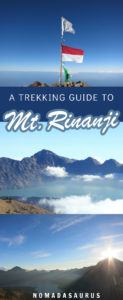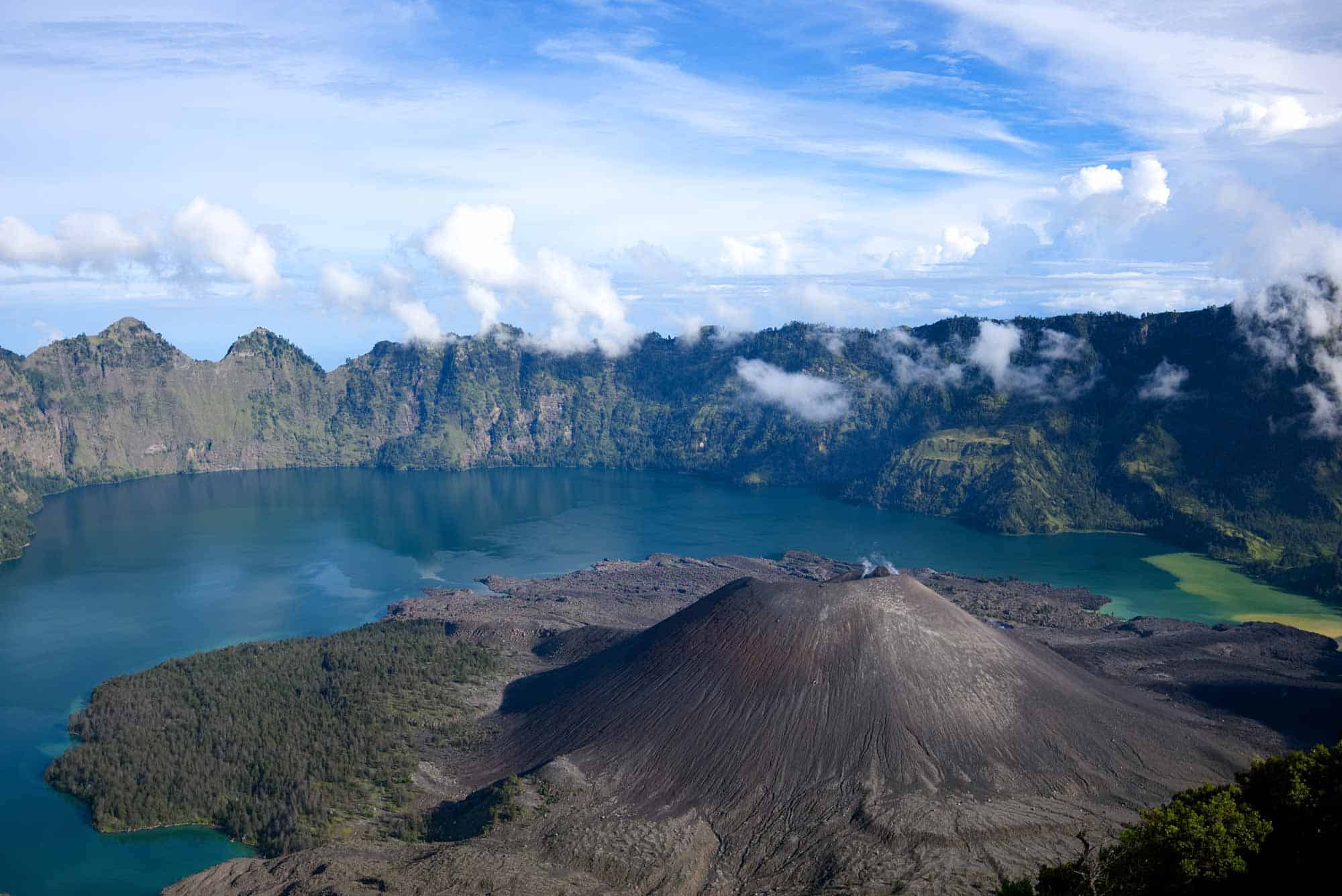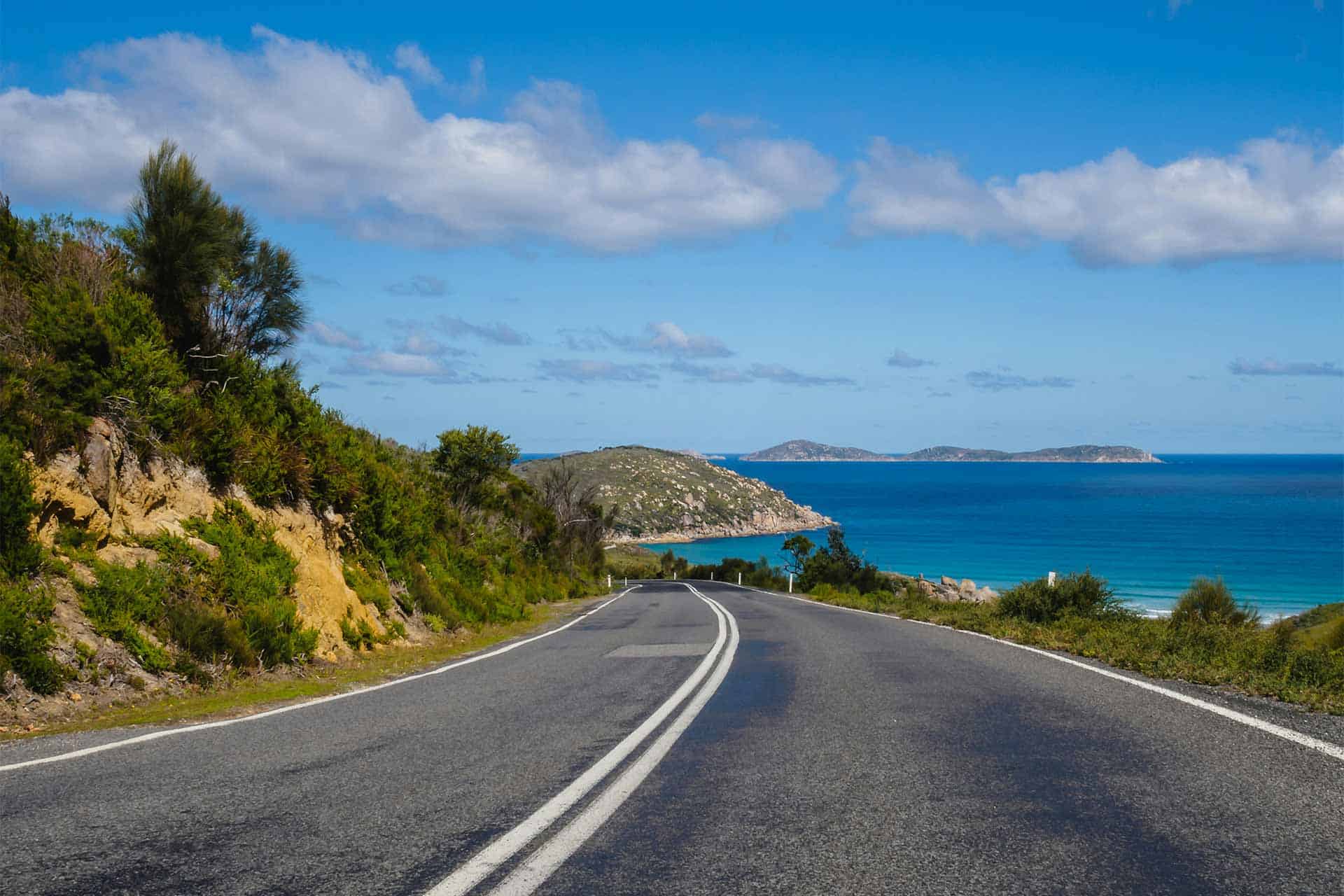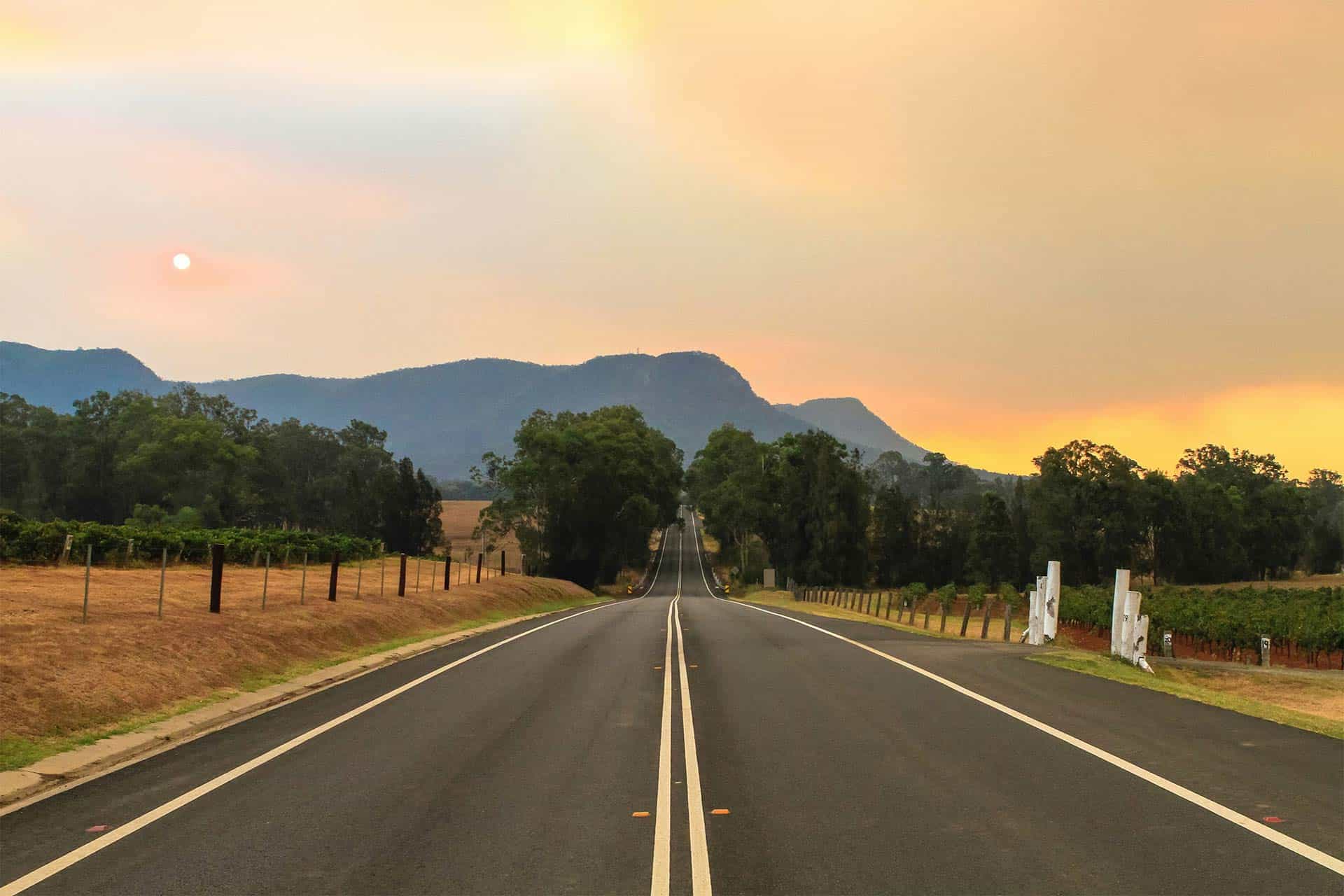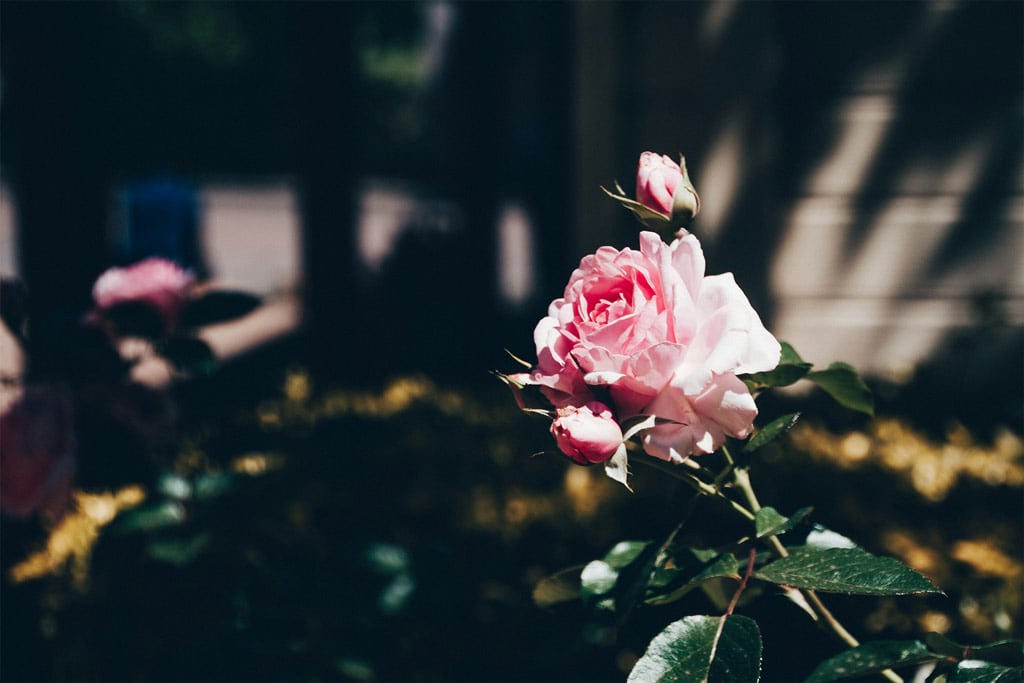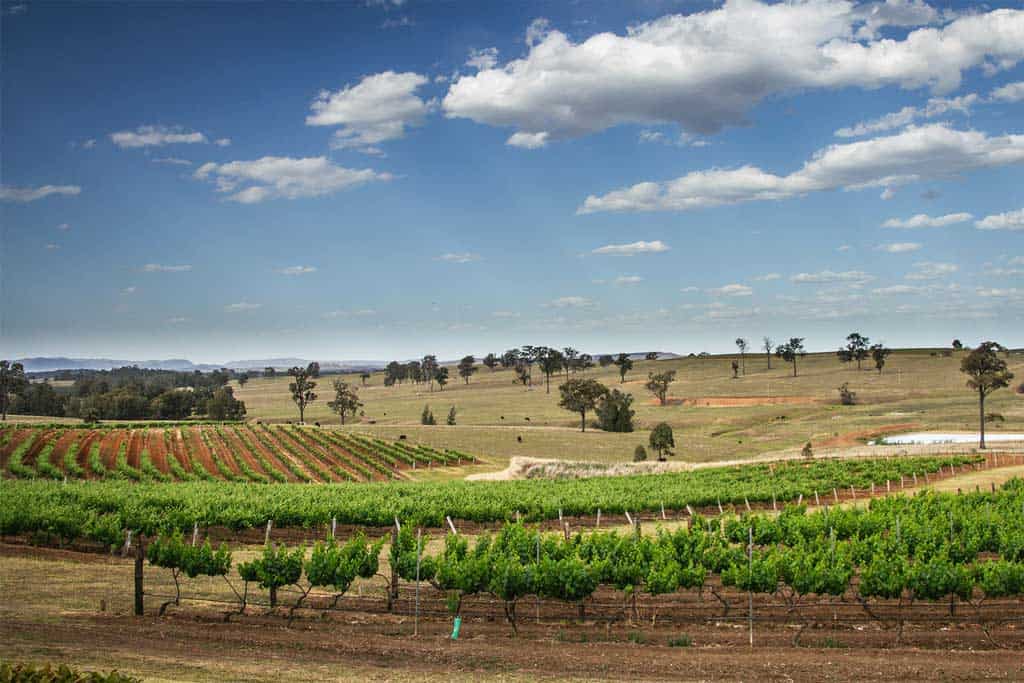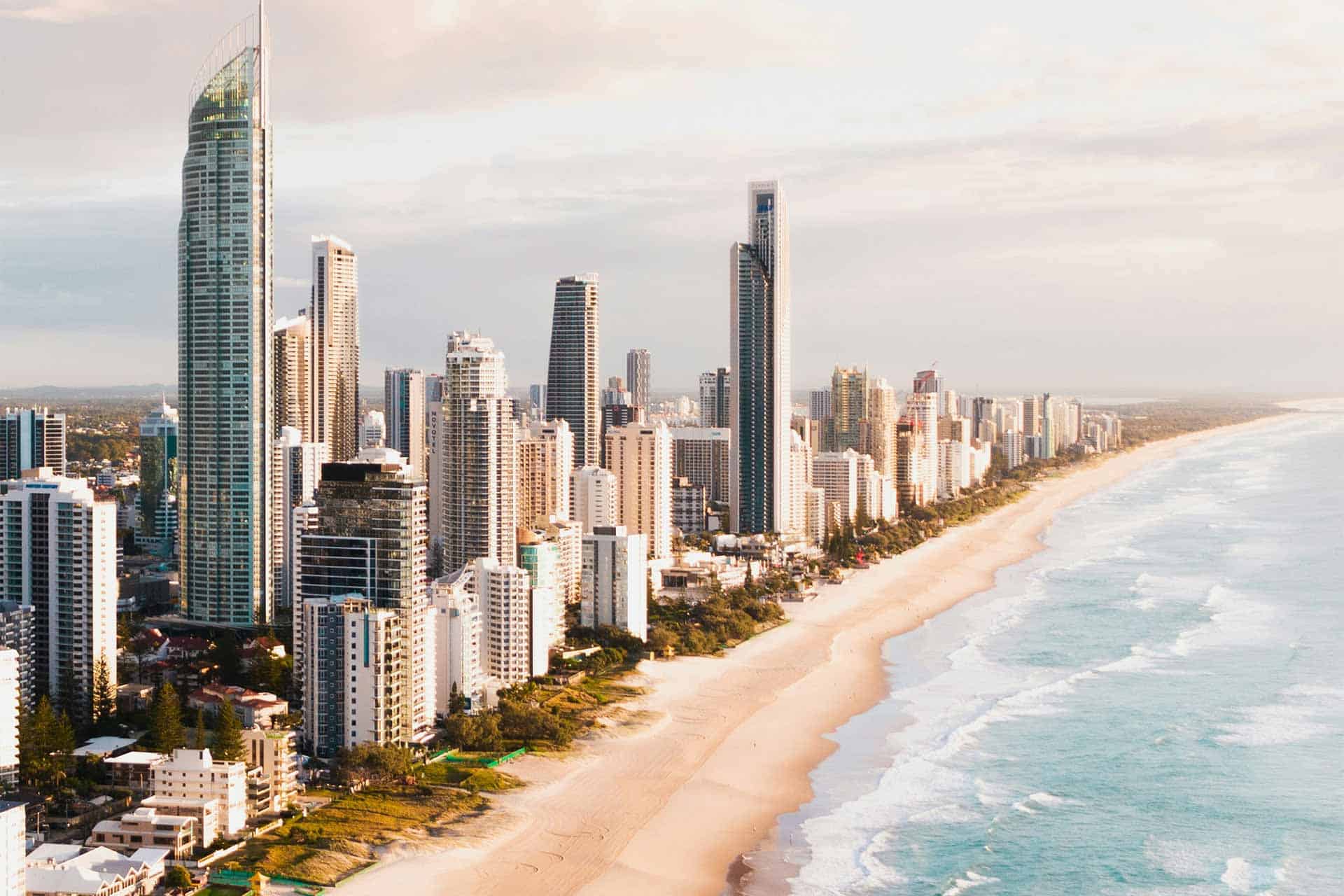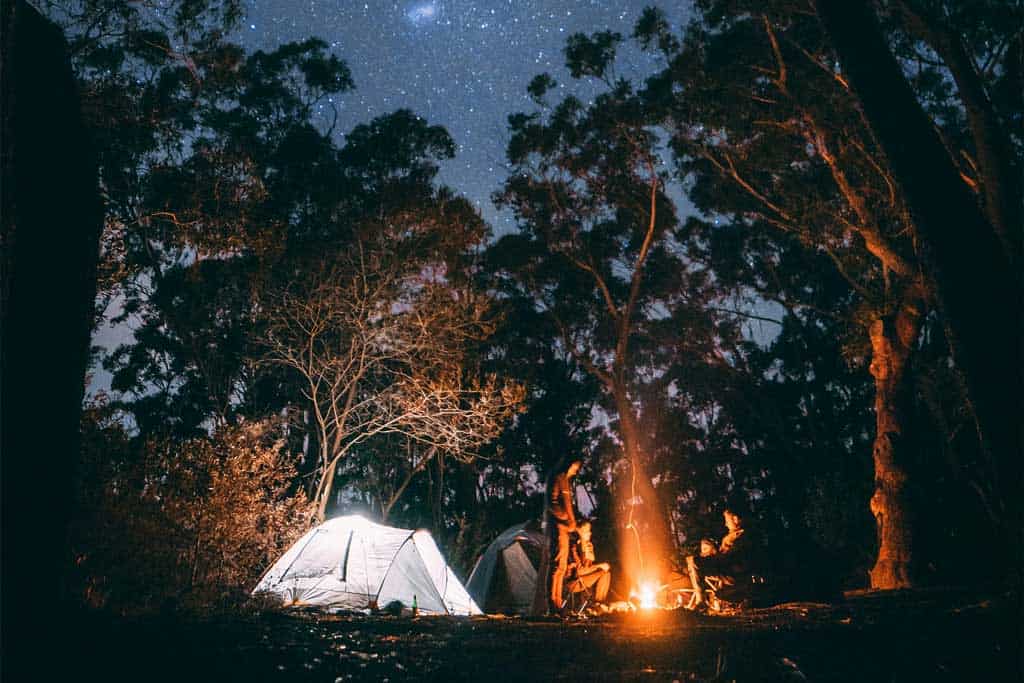A Mount Rinjani trekking tour is not for novice hikers or casual travellers. But if you’re ready for an epic 3-day journey to the summit of the second highest volcano in Indonesia, here’s everything you need to know before you go in our guide.
At 3,726 metres above sea level, Mount Rinjani looms large over the entire island of Lombok in Indonesia.
Of the 130 volcanoes in the country, Rinjani is the second-highest (topped only by Mount Kerinci on Sumatra).
Rinjani’s ominous silhouette is a constant reminder of the powerful forces rumbling just beneath the surface of the earth.
That power is what draws hundreds of intrepid hikers to Rinjani every day.
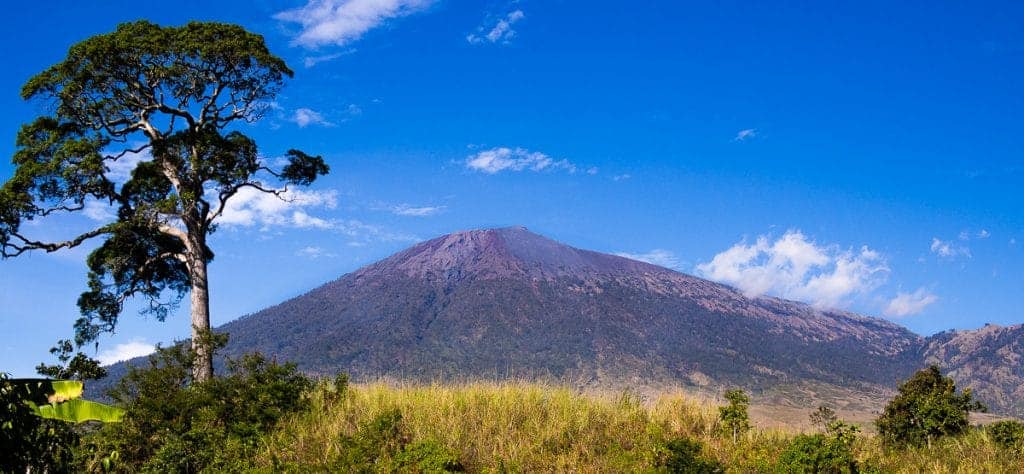
Why Do a Rinjani Trek?
The tough hike to the crater rim is rewarded by absolutely magnificent views.
Rocky black soil at the summit drops off into a lush valley filled with purples so deep and greens so bright they don’t look like they should exist in nature.
Lake Segara Anak, nestled in the bottom of the gaping crater, is a deep turquoise, echoing the spectacular colour of Lombok’s seas.
On the edge of the lake sits an active volcano, Mount Barujari, which steadily spews threatening clouds of smoke into the air.
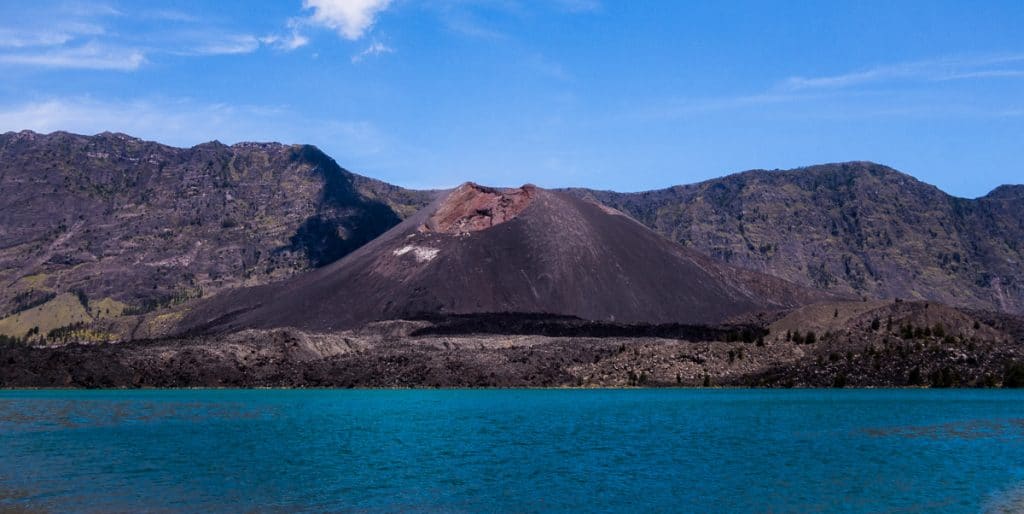
And at night, the sky is blanketed with stars so thick they look painted on.
While the views inspire awe, the most compelling reason to trek Mount Rinjani is to challenge your body and your mind, leap firmly out of your comfort zone, and be able to shout “Hell yes, I did it!”
If that sounds good to you, read on for everything you need about…
How to Plan Your Epic Mount Rinjani Trekking Adventure
Could You Handle a Rinjani Trek?
I’ll admit, we went into the Mount Rinjani trek with a bit of a cavalier attitude. Sure, we’d read the stories about how hard it was supposed to be, but we’re experienced trekkers with decades of challenging mountain hikes behind us.
We’ve trekked all over Canada, Europe, and even in Vietnam.
How much harder could trekking Mount Rinjani possibly be?
As it turns out, trekking Rinjani is hard. Really freaking hard.
The Rinjani trek starts with a climb of 1500 m over 8 km. Most of that elevation change takes place during in the final 4 km, which take about 4 hours.
Yep, that’s just one measly kilometre an hour.
To make matters more difficult, there is next to no trail maintenance, so the route is sandy, slippery, and ridiculously steep.
Unless you’re a trail running hero or an actual superhero, be prepared to have your will and your body pushed to their limits on your way up Mount Rinjani.
And that’s just the first day.
The second day starts in the middle of the night, so hikers can summit for sunrise. To get the summit, there’s another 1000 m of elevation gain, along a narrow trail of slippery loose scree.
It’s cold up there, too. Even in August, the temperature hovers around freezing.
After all the climbing, the descent should be a relief. Instead, it seems to go on for days, requiring every ounce of hamstring strength you can muster, plus knees of steel, and an excellent sense of humour.
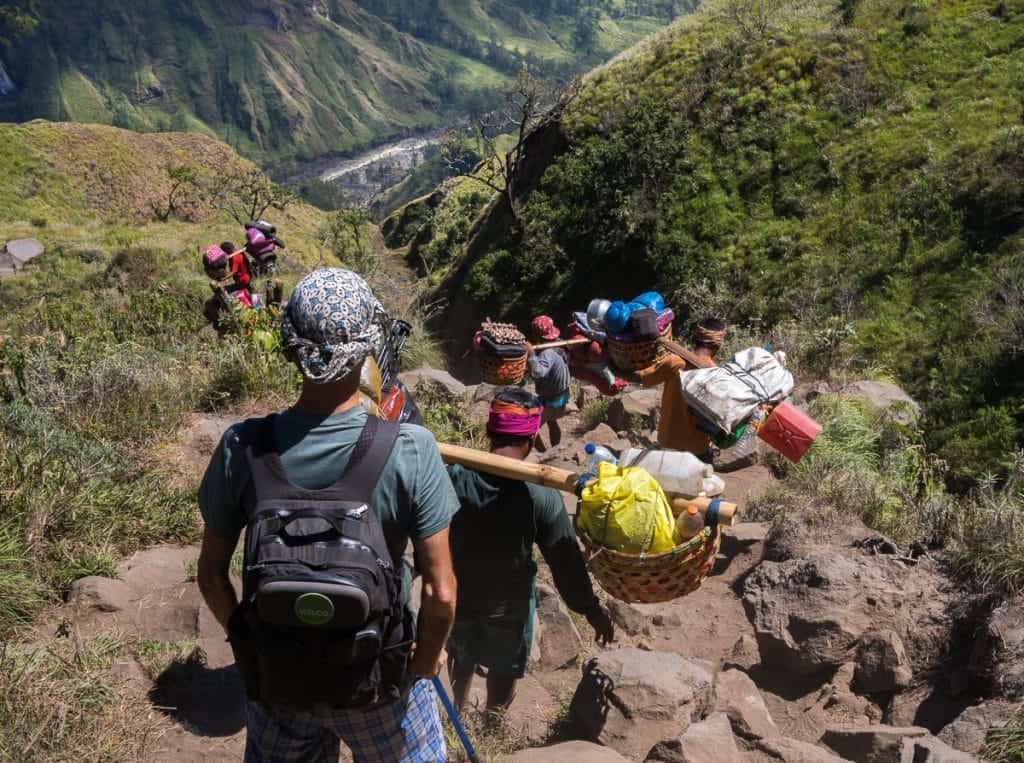
If you come away without any scraped knees or sore muscles, you’re definitely part mountain goat!
So, could you handle trekking Rinjani?
If you’ve read all of this and you’re thinking “Hell, yeah! Bring it on!” then keep reading.
If you’re still not sure, check out my 7 Essential Tips For Surviving A Mount Rinjani Trek →
What Are The Options For a Rinjani Trekking Tour?
Sembalun Or Senaru: Where To Start?
There are two main points of entry to Rinjani National Park.
You can ascend from the village of Sembalun or from Senaru. On three- and four-day hikes, you depart from one village and descend to the other.
We highly recommend starting in Sembalun because of the way the trails are configured.
The first day of ascent from Sembalun is steep and sandy. It looks like it would be absolutely brutal going in the opposite direction.
Likewise, the descent to the crater lake is so steep and rugged, that it would be a real leg-breaker going the other way.
If you want a more off-the-beaten track experience, book a private tour and ask about one of the less-used routes, like the trails from Aik Berik or Torean. We wish we had known about them before our trek!
How Many Nights on Rinjani?
Three Days, Two Nights
The most popular option (and the one we recommend) is the 3-day, 2-night trek. This gives you just enough time to climb to the summit and also visit the crater lake and hot springs.
If you’re in no rush, consider the 4-day, 3-night option, which goes to the same locations but provides a little more free time to relax and enjoy Mount Rinjani.
Two Days, One Night
The 2-day, 1-night tour from Sembalun includes the option to summit at sunrise. If you’re in amazing shape and love to punish your machine, go for it!
Otherwise, take pity on your poor body and give yourself more time on the mountain.
The 2-day, 1-night trek from Senbaru takes trekkers to the crater rim opposite the summit. This is the easiest (not to say that it’s easy) of the Mount Rinjani trekking options.
You don’t get near the summit or the lake but it does provide incredible views of the crater. If you think you can’t handle a longer trek but still want to experience Rinjani, this is probably the best option.
If you book the full 2-day, 1-night tour on Klook they will pick you up from anywhere in Lombok and provide everything for you.
BONUS – Booking ahead of time ensures you won’t miss out on the tour, and get the best price too! And just for NOMADasaurus readers, if you use the Klook discount code “NOMADS10” on the website when checking out, you’ll get $10 off your first booking!
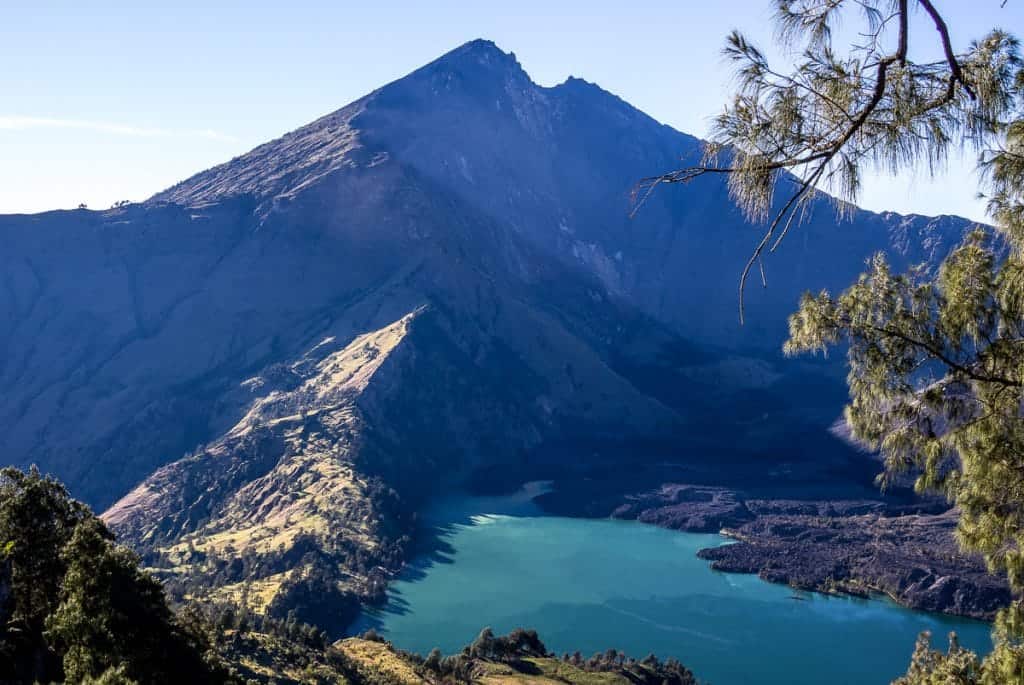
Be aware that “one night” or “two nights” refers to number of nights on the mountain. Most Rinjani trekking companies encourage you to spend a night in Senbaru before the tour to get an early start. This hotel is often included in the price, but be sure to check!
Private Tours and Hiking Rinjani Without A Guide
While it is technically possible to trek Mount Rinjani without a tour or a guide, it is actively discouraged both by the government and the community. Unless you are an extremely experienced hiker and have hiked in the tropics before, don’t even consider it. If you’re injured on the mountain without a guide or porters, you’ll be in some serious trouble.
If you do decide to trek Rinjani independently, please sign in at the park office and pay the entrance fee. Though it’s questionable whether the fees are used to maintain Rinjani, signing in is for your own safety.
What’s The Food Like On A Rinjani Trek?
On our day-one lunch break, we were astonished to see full-on camp kitchens being set up by all the guides and porters on the mountain.
In Canada, you’re lucky to get a squashed peanut butter sandwich for lunch on a long hike.
On Rinjani, you get a heaping plate of fried vegetables, tofu and tempeh, a pile of freshly cooked rice crackers, all the rice you can eat, plus a massive fruit plate for dessert. And that’s just the vegetarian option!
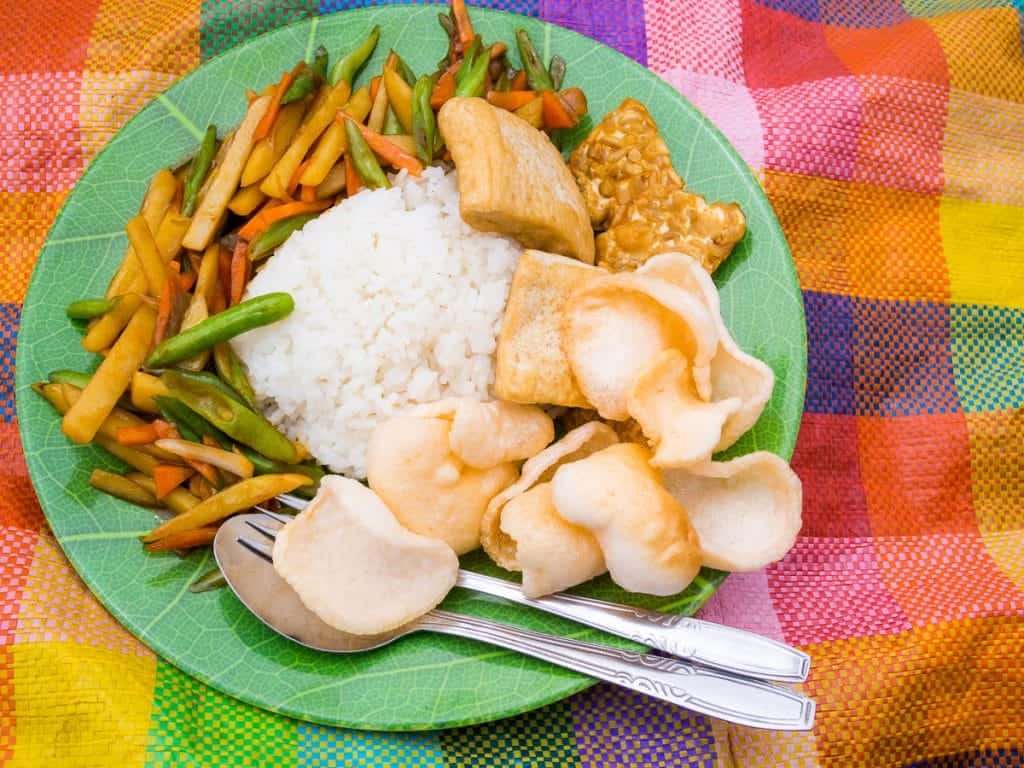
This meal was not unusual. Everything we ate on Rinjani, and everything we saw being served to fellow trekkers, was freshly cooked and plentiful. There was so much food, we were rarely able to finish our meals.
Where Do You Sleep On Rinjani?
You’ll sleep snuggled in a tent at a campsite on the crater rim or by the lake.
Our tent was clean and modern, if a little bit short for our long bodies! The sleeping bags had been freshly laundered and the camp pillows were also clean.
You won’t find much solitude at your campsite though, since hundreds of other trekkers will be camping right alongside you.
What Does A Rinjani Trekking Tour Cost?
There’s a huge range of prices for trekking Rinjani, depending on which company you go with, where and when you book, and which tour option you choose. I saw prices quoted anywhere between $80 and $450 US for similar tours.
Avoid the cheapest companies, as many don’t provide essential services like an experienced guide, good sleeping bags, garbage pack-out, and a toilet tent.
You can save money by booking once you’re already on Lombok. Just make sure you know which Rinjani trekking company you’re going with so you can ask the essential questions and check their reviews.
If you don’t have time to wait around on Lombok looking for a tour with availability, it is best to book ahead. Check out some of the tours I’ve linked to on this page.
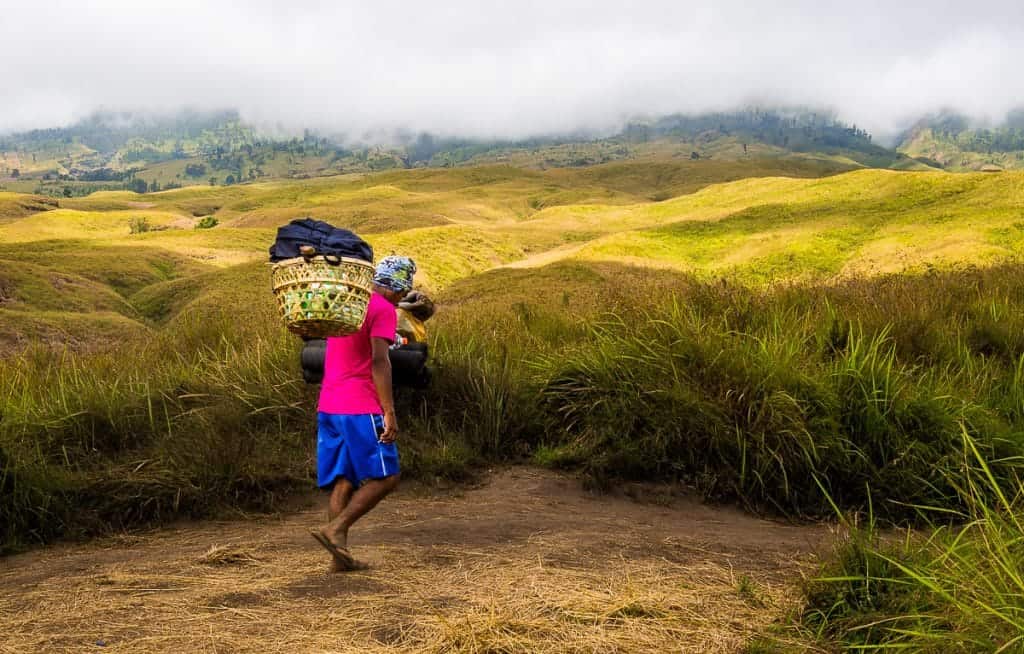
Budget a little extra for tipping. After you see how hard your porters and guide work, you will be happy to supplement their incomes.
A minimum of 100,000 IDR (around $8 US) per guide/porter from each hiker is a good guideline.
Other Important Things To Know For Your Trek
All visitors are not allowed to bring any plastic that can potentially become waste. So visitors are advised to bring refillable drinking water bottles, food containers to carry food such as snacks, biscuits, bread, and the like.
There are only 400 trekking permits issued a day (240 permits for international hikers and 160 permits for domestic hikers). So make sure you reserve your place in advance!
How To Choose The Best Rinjani Trekking Service
Choose your Mount Rinjani trekking package carefully. Yes, you can pick up el cheapo tours after you arrive in Lombok but you tend to get what you pay for on Mount Rinjani.
I recommend ignoring the cheapest options and spending a little more to ensure you are comfortable and safe on the mountain.
Hajar Trekking took excellent care of us during our Mount Rinjani tour. We can enthusiastically recommend them.
Hajar grew up in Senbaru and he cares deeply about the mountain and the future of tourism there. Our guide, Adi, was funny, informative, and always put our safety first.
He has been up the mountain hundreds of times, knows every rock and tree root on the trail, and was patient with our endless stops for photos and videos.
If you mention the code “NOMAD TO RINJANI” when you contact them via WhatsApp or email they’ll offer you a special discount 🙂
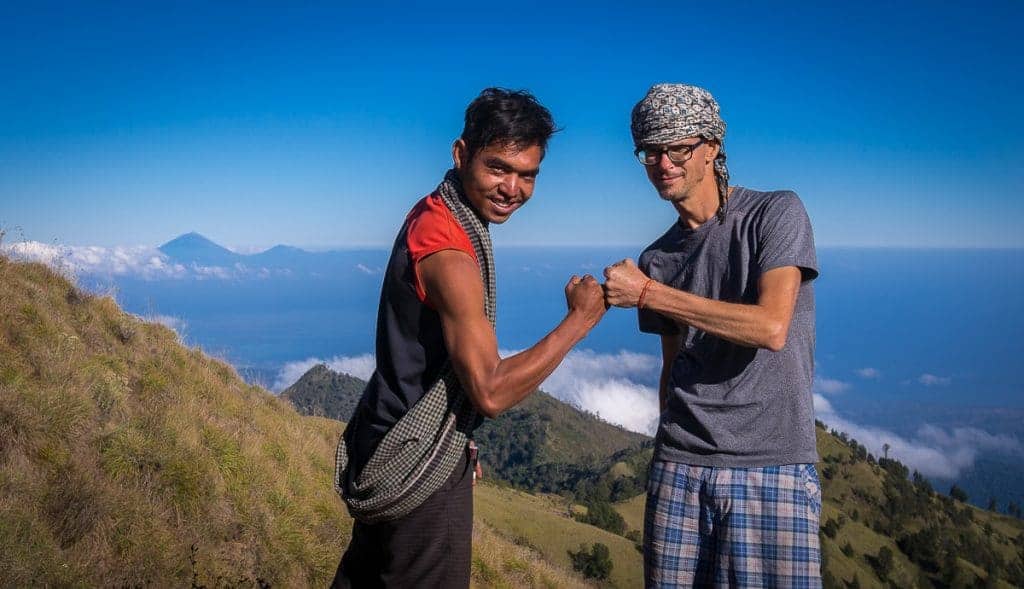
The two porters who took care of us were just amazing, too, working their butts off to lug our camping gear and food up the mountain and to get our campsite set up and perfect before we arrived.
What’s Included On A Mount Rinjani Tour?
These are the things that should be included in your Rinjani trekking package. If they aren’t, look for another company.
- One English-speaking, licensed, experienced guide
- One porter per person in your group
- Meals, snacks, soft drinks and water
- Tent and sleeping bag
- Transportation to and from any town on Lombok
- Transportation between Senbaru and Sembalun
- Hotel stay in Senbaru the night before the trek
Some companies provide a few nice-to-have extras. This is what we got:
A toilet tent allowed us to do our business in private and to bury our waste. Without a toilet tent, you take your chances in the bushes where privacy is very hard to come by.
A camping pillow which helped us get a better night’s sleep.
Two camping chairs that kept us out of the thick Rinjani dust at mealtimes.
Winter jackets to keep us warm at the top of the mountain. Even in August, the summit was around 5 degrees celsius! Brrrr.
We recommend having a good backpack for hiking as well.
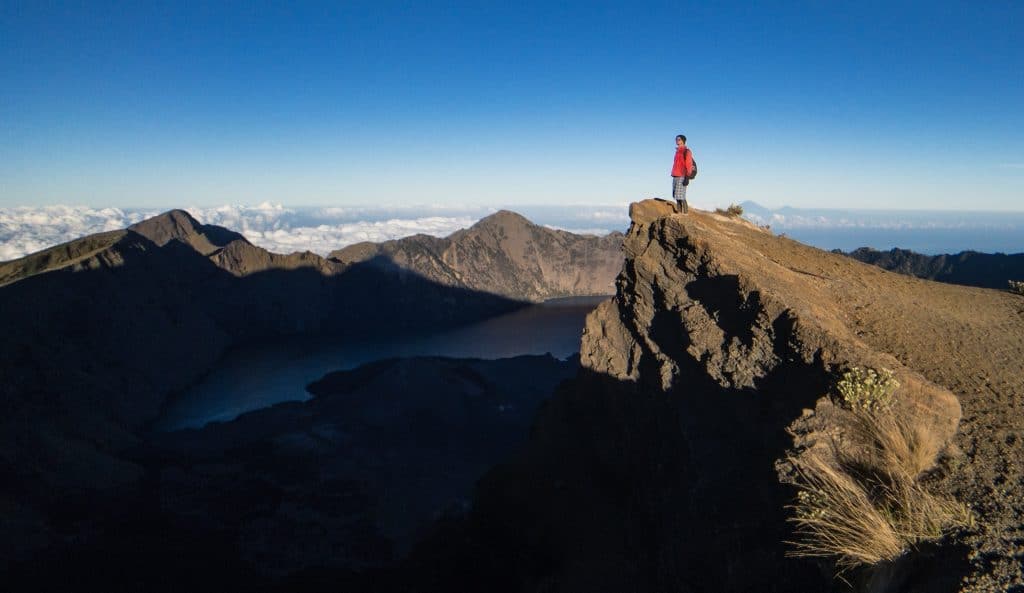
Headlamps to make the ascent to the Rinjani summit possible. A headlamp leaves your hands free to carry trekking poles or help you scramble up the steepest sections.
Trekking poles to save your knees on the steep descents and give you extra ability to balance on the often treacherous trails.
Other Essential Questions To Ask About Your Rinjani Trekking Package
What do the porters carry? Usually, hikers carry all their personal items (clothes, toiletries etc) and the porters carry food, water and camping equipment.
What is the group size? We were on a private tour, but if you go with a group, be sure to ask about the group size. The larger groups on the trail tended to be noisy and experience more delays.
What do they do with garbage? You are going to go through a lot of food and water on the trail. Make sure your tour company pays their porters to carry your garbage out, instead of dumping it or burning it on the mountain. There is a lot of garbage on Rinjani – please don’t add to it!
Are there restrictions for what we can bring? To reduce waste on the mountain, visitors are not allowed to bring any plastic. Pack food and drinks accordingly!
Who runs the company? What is their story? We love to travel with private companies run by local people. They tend to care deeply about the environment and the longevity of their business and less about earning a quick buck.
Tips For Trekking Mount Rinjani
Request trekking poles. We had never trekked with poles before but they were indispensable for this trip. They’ll help keep you upright through the sandy, slippery slopes and will save your knees after hours of steep descents.
Be prepared. The trail will probably be harder than you think. Take your time, stopping every few steps to catch your breath if you need to. If you just keeping taking the next step and then the next, you will eventually make it to the top. Read up on our top hiking tips for beginners for more help.
Be OK with not summiting. Don’t be ashamed to say “no” to the sunrise summit trek. Plenty of people don’t go up! If the first day nearly killed you, stay in your tent and rest. There is plenty of exciting hiking to come without risking injury or exhaustion just to see the summit.
Don’t get too cocky on the descent. The trail down is steep and precarious. It’s easy to slip and fall and even easier to injure your knees. Just because the porters are running down the trail in flip-flops doesn’t mean you have to do it too!
Be respectful. Try to stay aware on the trail, even when you’re exhausted. Let faster hikers go by you and always move over for porters. Remember, they are working while you are there for fun!
Don’t add to the Rinjani litter problem. It’s no secret that there is a lot of garbage on Mount Rinjani. Bring a bag with you and please pack out your own toilet paper, baby wipes, cigarette butts and other personal garbage. If you want to do more, bring a garbage bag and pick up rubbish along the trail. You are not allowed to bring plastic!
Rinjani Trekking Packing List
Bring as little as possible. If you think you’ll survive without something, leave it behind! You’ll regret the extra weight when you’re on your 1200th metre of ascent for the day!
- Hat, gloves & scarf (it’s very cold at the top)
- Good hiking shoes (running shoes are not grippy enough)
- Headlamp (for the night hike to the summit)
- One/two sweat-wicking t-shirts
- One pair of shorts
- One pair of long pants
- Toothbrush & toothpaste
- Sun hat (if you don’t have one make this easy DIY hat)
- Sunscreen
- Lip sunscreen (our lips got burned – not a good look)
- Sunglasses
- Socks & undies
- Swim suit
- Tiny towel
- ID and cash for tipping
Optional items:
- Base layer (it gets freaking cold at the summit)
- Baby wipes (if you pack them in, pack them out)
- Soap or hand sanitizer
- Flip-flops
That’s everything you need to know before you book your Rinjani trekking tour. If we missed something or if you have questions, ask away in the comments section below!
Disclaimer: We were guests of Hajar Trekking for our Rinjani trip. But we would never recommend something we didn’t love ourselves and you know Jarryd and Alesha wouldn’t let us get away with it either!
Save this Pin for later?
